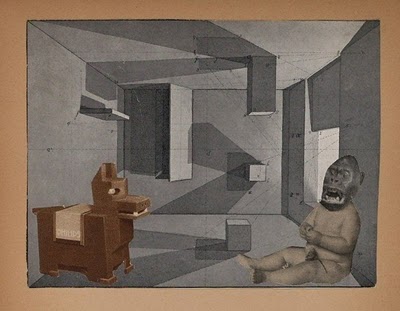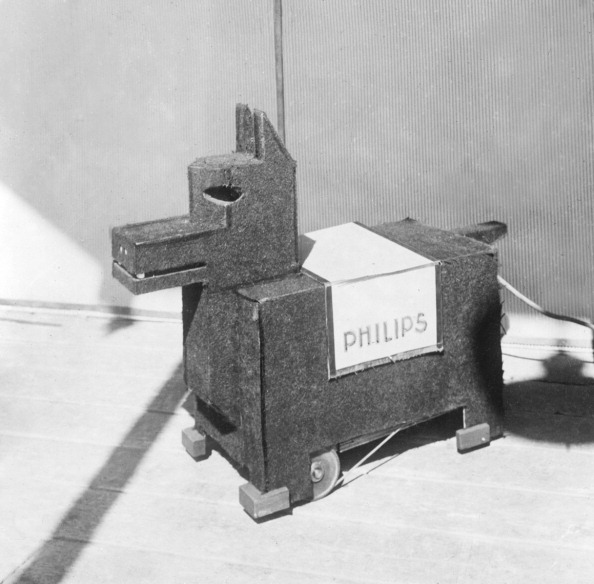This is what everyone’s been waiting for – new and more detailed information on “Philidog” by Henri Piraux (sometimes Henry Piraux, of Philips France).
One of the articles to be presented tells us that the dog has gone through a bit of an evolution. Unfortunately I’ve been unable to get a date of the original incarnation. Here’s the list of versions created:
1st was not mobile,
2nd was mobile and batteries,
3rd was mains powered,
4th mod included touch sensitive whiskers.
Image source: Getty images
I was fortunate enough to locate an article that gives a description of operation, as well as a circuit diagram!!
The Anatomy of PHIL the Radio Dog
An ingenious device has been produced by Philips Radio for demonstrating the working of their new photo-electric cells. This is “Phil,” the “Radio Dog.” Wherever he has been exhibited, his ability to bark and to move forward or in circles at the command of his owner, has caused much speculation, Below we unveil the mystery of his anatomy.
Fig. 1 shows the radio dog deprived of his external covering [not the above pic]. The “eyes,” formed by two photo-electric cells stand out clearly, Furthermore, there are the amplifying valve’s and several relays, an accumulator, batteries, and several other electrical accessories the operation of which will be explained in the continuation of this article.
A photo-cell consists at an exhausted glass bulb containing two electrodes. One electrode consists of a metallic mirror deposited  on the inner side of the bulb, while the other electrode is a spiralised filament. The metallic mirror will emit electrons when light falls upon it, just, as in the case of the filament of a radio-valve. If the metallic mirror is connected to the negative pole, and the spiralised filament to the positive pole of a source of voltage, these electrons will be attracted by the anode so that by exposing the photo-cell a current is generated.
If a resistance is placed in the circuit, there will be a drop in potential dependent on the strength of the photo-electric current passing through it.
As the resistance is also included in the grid circuit of the amplifying valve, this drop in potential at the same time controls the amplifying valve, so that the anode current of the valve is altered in the same ratio as the current passing through the photo-cell.
Fig. 2 shows the next stage [not shown but included in Fig 4.]. For the sake of simplicity we assume that relay 1 is in direct. connection with the positive pole of the anode tension supply. A relay is an apparatus which makes it possible to close with low power a second circuit for higher power. It consists of an electro-magnet and a movable armature which, being attracted, makes and breaks contact when the magnet is excited by an electric current.
With the Radio-Dog, when the photo-cell is exposed to light, the anode current of the amplifying valve passes through Relay 1 (Fig 2), so that the armature is attracted and closes contact C. This excites Relay VII., the result being that armature AIV is changed over and motor MI switched on via contact D.
As the other “eye” can start the second motor in an entirely similar manner, both motors will turn when both “eyes” are exposed, thus causing the dog to move forward The two motors are entirely independent of each other, so that by exposing only one of the photo-cells, one of the motors is made to turn, thus causing the Radio-Dog to revolve on its axis.
“Phil” can also bark like a real dog. Fig. 3 shows [not shown but included in Fig 4.] the circuit by which this effect was obtained. The anode current of both amplifying valves passes through relay III., which is connected in series with the anode supply of both amplifying valves. The adjustable resistance, R4, is shunted on its winding in order to regulate sensitivity. This resistance has been adjusted in such a manner that relay III. does not operate until the two valves supply their saturation current. This is the case when the photo-cell is strongly illuminated. Then armature AIII. is attracted, thus exciting relay VI.
As armature AV. is changed over, the supply of the two motors via contact F is interrupted, so that the dog stops, and as armature AVI. touches contact G, the horn is operated. Moreover, an interrupter is incorporated in the horn circuit, so that the dog does not keep on howling, but barks only at intervals.
If the above description is read attentively, will be easy to follow the complete circuit diagram of the Philips Radio-Dog, as shown in Fig. 4. The greater part of the electric currents supplied are obtained from the lighting mains by rectifiers.
From San Antonio Light newspaper 08 June 1930 p59 -text below
Le chien de garde electrique (electric watchdog) was the hit of the recent radio show in Paris, where its “kennel” drew greater crowds than did the blue-ribbon winner at the Winter’s dog show.
Mr. Piraux’s first canine robot merely barked and worked its jaws whenever light fell on its glassy eyes. The power for this was supplied from a storage battery, inside the wooden hound. Then the inventor put wheels on the legs and supplied them with motors to pursue anyone who turned a light on the automatic animal.
These, however, with the storage battery, made too much weight for the power and resulted in such a slow-footed “dog” as to be unimpressive.
To pep him up, the inventor removed the battery and connected his pet with a long wire to the electric light socket. This had the effect of making the “chien electrique” as quick and vicious as if he had been fed all Winter on raw meat. Being a patriotic Frenchman, M. Piraux, of course did not build his chien on the lines of the German police dog nor the English bull either, but chose the French poodle which, to his mind, is the noblest form of canine life.
In the head of the 1930-model mechanical poodle are eyes, containing lenses behind which lie photoelectric cells. As long as no light falls on these nothing happens. But, if someone lights a match or turns the rays of a flashlamp in their direction, the light passing through the lenses causes the photo-electric cells behind them to allow a current to pass through. This current is amplified by two radio tubes and several relays before reaching the motor.
One of these motors works the lower jaw and its teeth up and down and with the same action draws a phonograph needle over a steel record, producing a series of growls and barks, calculated to alarm the invader and rouse the household.
This much happens whether the light falls on either eye or both. The mechanism that sends the mechanical Towser in pursuit of the person carrying the light is more complicated.
If the light falls on the left eye, the photo-electric cell beneath sends current only to the wheel on the right side. When the light falls only on the right eye, the opposite happens.
In either case the result is to turn the “animal” around until it is headed for the light, which then falls on both eyes alike and then both wheels revolve at the same speed, causing the robot poodle to charge at the source of the illumination, barking and snapping as he goes.
Provided the sudden, noisy interruption does not scare the wits out of the burglar, he probably could avoid the jaws easily enough, because they only work vertically, but the inventor has added another feature more suggestive of the cat family. This consists of a set of long feelers, or whiskers, made of pointed steel and electrically charged.
It would be harder to avoid these, and if one touches him the intruder will find the dog’s sting worse than his bite. A bullet shot into the mechanical mutt would probably cause it to die of short circuit, but after the barking and the firing no burglar would hesitate about getting out of the neighborhood as fast as he could.
The synthetic dog cannot be chloroformed, poisoned or beguiled by meat and candy but he has other faults. He is too incorruptible. The average family dog, left to sleep downstairs by the door, uses some discretion, like a policeman. He recognizes the belated steps of the head of the house, even if they are a trifle unsteady, and known it is not necessary to betray the fact that he ia coming home at an unseemly hour.
But how is the mechanical Fido to know who is who? It might not be so hard to sell these dogs if only the man of the house would be exposed, but nowadays, everybody, including the flapper daughter, has a latch key and sometimes “checks in” a little later than she wants to advertise.
M. Piraux is ready to adapt his idea to all sorts of other forms besides the dog. In a museum, where it would not be desirable to have the electric animal charging around among glass specimen cases, he suggests on the wall a bison’s head that will bellow and keep it up till the watchman comes and opens a switch, or a suit of armor that can be made to swing a sword or battle axe.
From the French magazine Atomes Oct 1957
“Il fut présenté en 1929 au Salon International de la T.S.F. de Paris et à l’Exposition Internationale de Magic-City. Il était l’oeuvre d’Henry Piraux, aujourd’hui chef de la propagande technique à la Société Française Philips, qui doit donc être considéré comme un pionnier de la cybernétique. Sensible à la lumière, ce chien suivait une torche électrique, tournait, virevoltait autant de fois qu’on le lui commandait. Mais, quand on lui présentait la lumière de trop près, just sous le nez, il se mettait à aboyer, pas content du tout.â€
translation:
“It was presented in 1929 at the International Salon of the TSF in Paris and at the International Exhibition of Magic-City. It was the work of Henry Piraux, now head of technical propaganda at the Philips company in France, who should hence be considered as one of the pioneers of Cybernetics. Sensitive to light, this dog followed an electric torch; turned and twirled around as often as it was told to do. But when the light was presented too closely, just under its nose, it started to bark, not happy at all.â€

Collage by the French Surrealist artist, Andre Breton (from here).
See other early Electronic and Cybernetic Animals here.

One Reply to “1928 – Phil the Radio Dog a.k.a. “Philidog” – Henri Piraux (French)”
Comments are closed.